by Julie McConnell | Jun 30, 2015
If you’ve been gardening for more than a few years, you may be confused by UF/IFAS recommendations that conflict with practices you’ve used for years. You aren’t imagining things, we do change recommendations based on the most current research available to help you with your agricultural endeavors.
I want to share a few common mistakes that gardeners make based on old recommendations but that research has shown are not the best choices. Check out the list below to see if you can break an old habit or two!
| Old Habit |
Current Recommendation |
| Throw a little “starter fertilizer” in the hole (or under new sod, seed, etc.) |
It is not beneficial to add fertilizer to plantinghole or under newly installed sod.Quick release (soluble) fertilizer may burn roots if added to planting hole.If applied properly, a slow release fertilizer may be applied to trees and shrubs but should be applied to the top of root ball or mulch following label instructions.Turfgrass grown from seed, sprig, or sod does not use fertilizer efficiently at planting. Wait 30 days to apply fertilizer – after roots have been established. |
| Dig the hole twice as deep and wide as the root ball for trees and shrubs |
1.5 times the width of the root ball is good, but planting too deep can be a death sentence.Planting depth should be 10% shallower than the distance from the topmost root to the base of the root ball. |
| Mulch 3-5 inches deep |
2-3 inches with a very thin layer directly over the rootball (less than 1 inch) and none touching trunk. This is the ideal amount to conserve water and suppress weeds. |
| Native and drought tolerant plants don’t need water |
All plants need water until established – depending on the type and size of the plant, weather, and soil conditions this may take months.Always plan to give a little TLC to newly installed plants no matter how tough they are supposed to be. |

by Roy Carter | Apr 27, 2015

UF/IFAS Photo: Tyler Jones.
Most people know that an attractive landscape adds to the value of a home. For most of us, the landscape also represents a hefty investment of money, time and work so it’s important to know enough about landscape design to do the job right.
An important step in developing an attractive landscape is spacing plant materials correctly. Plants should be placed in the landscape in relation to each other, and with some understanding of their ultimate height, spread, and growth rate. However, the endless variety of plant sizes and shapes can easily complicate this matter for the home gardener.
How the plant is used in the landscape will determine its shape to a large extent. For example, if a plant is part of a hedge row, it should be placed close to the other plants so that in a few years, all of them grow together. If you want to retain the individual shape of each plant space the plants further apart.
Spacing trees correctly is very important as trees are the largest and most permanent of all landscape materials. Here are a few examples of some ways to use trees effectively around the home:
- Pine trees look very good as a tall background screen in the landscape. To have the trees work as a screen, plant them eight to twelve feet apart measuring from the center of one tree to the center of the next.
- Mass planting of dogwood, redbud and crape myrtle make brilliant assets to your landscape. If these trees are spaced about 12 to 15 feet apart, the top foliage should meet in a few years. When these trees are in bloom, the mass plantings will enhance their show of flowers.
- An oak tree planted on the west side of your lot will provide shade for your home, the tree should be planted about thirty feet from side of the house, to prevent tree limbs from eventually crowding the house.
As you can see, it’s important to learn as much as possible about trees you select for your landscape. In spite of the few examples given you, there is no single standard recommendation on spacing trees in the home landscape. This is because most of the popular landscape trees can range from 10 to 100 feet in height, and vary as much in spread. Specialists recommend that the minimum spacing for landscape trees should be one half of the spread of the tree’s mature canopy from other trees, from walls and other existing structures. But even this minimum spacing may vary among different varieties of the same species. For specific spacing requirements for the tree you are interested in check with your local County Extension Office.
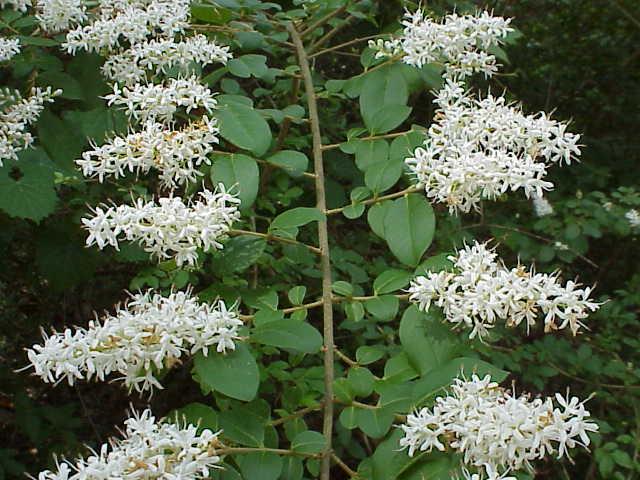
by Beth Bolles | Jan 13, 2015
The Chinese privet, Ligustrum sinense, is a plant that is well known to many people as a great nuisance in the landscape. It is also a Florida noxious weed because of its invasive nature.
Originally grown as an ornamental that formed a hedge and tolerated poor conditions, the Chinese privet has now spread to natural areas and grows easily on disturbed soils. Plants are full of white fragrant flowers in the spring with abundant small black fruit forming late summer and remaining into the winter. Seeds are easily spread by wildlife to new areas but new plants can also grow from roots.
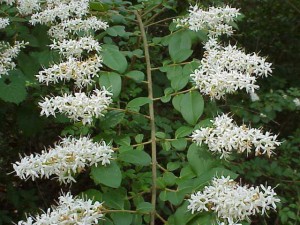
Privet may be best identified when it is in bloom.
Chinese privet easily forms a thicket, shading areas and impacting the growth of native plants. Homeowners can identify any plants growing on their property and work to manage Chinese privet when plants are not in seed. If you need assistance in identification, contact your local Extension office or view pictures online.
Even though homeowners will not find Ligustrum sinense in the nursery, cultivars of this plant may be found. One newer selection is ‘Sunshine’. This is a reportedly sterile cultivar that grows much smaller and has yellow foliage. Homeowners who choose to install ‘Sunshine’ may still need to be cautious since there has not been extensive research in Florida to verify that it will not become a future issue.
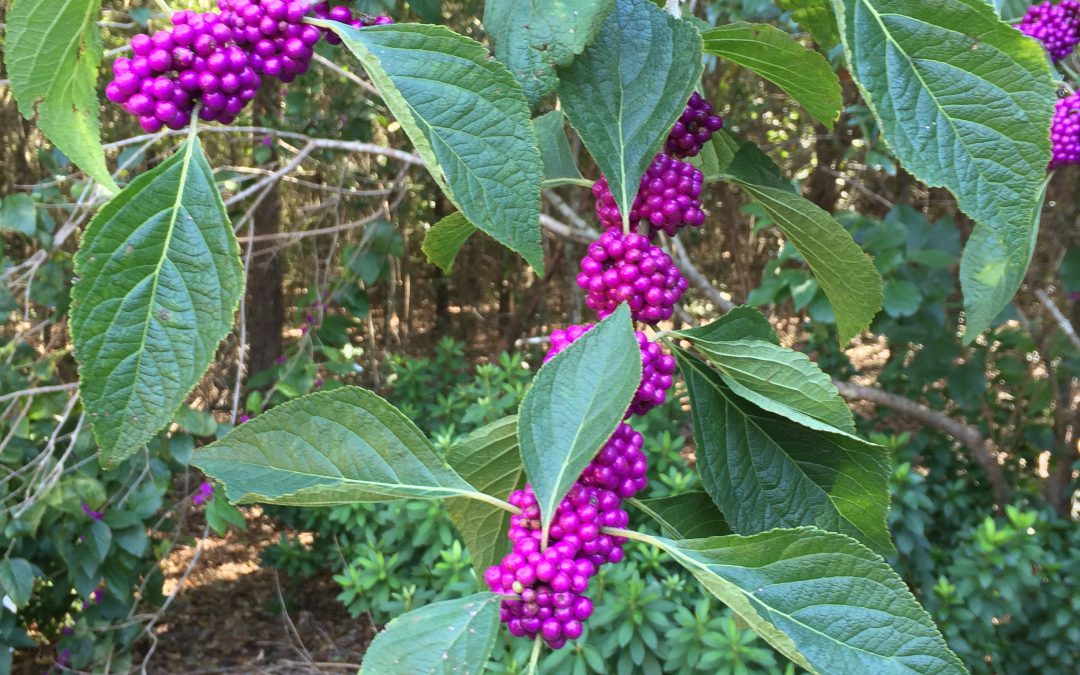
by Mary Salinas | Oct 21, 2014
This autumn you may notice shrubs with long, arching branches sporting clusters of shiny purple berries. That beautiful sight is the Beautyberry, or Callicarpa americana. This native is found throughout Florida and the southern United States, west into Texas and north to Tennessee and Virginia.
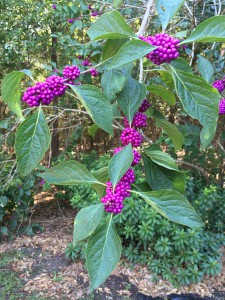
Beautyberry in the fall. Photo credit: Mary Derrick, UF IFAS Extension.
In the spring, lavender flowers adorn the branches and are a favorite of bees. The flowers eventually give way to the shiny purple berries in the fall. Birds find the berries very attractive and will feast on them when found. Mockingbirds and cardinals are especially fond of them. If you plant this shrub for the birds, one or two plants will provide more than enough of the berries to satisfy their appetites.
Beautyberry is adaptable to a wide variety of soils and moisture. After it gets established it is drought tolerant, however it can also do well in a moist area. A spot in your garden that gets partial sun is a perfect location. Plants in too much sun sometimes get a bit yellow and those in too much shade get leggy and don’t set as much fruit. Beautyberry is deciduous, meaning that it will lose all its leaves in the winter. Therefore, you may want to place it in an area of your yard where it won’t be a focal point in the winter.
This lovely plant is usually readily available at independent nurseries. If you prefer to grow your own, beautyberry is easy to propagate and grows rapidly. Snip off an approximate 6-inch piece from the end of a stem; the cut piece should have 5 sets of leaves. Snip off the bottom 2 sets of leaves – this part of the stem will be in the soil and roots will emerge from where the leaves were removed. Also snip off the top of the stem to include the top set of leaves. Your cutting will end up with only 2 sets of leaves. Immediately put the cutting in a good potting soil, making sure that the lower part of the stem where the 2 sets of leaves were removed is below the soil line. Keep the soil moist as the cutting develops a good root system.
You and the birds will enjoy this lovely shrub for years to come!
by Taylor Vandiver | Oct 7, 2014
I think it’s safe to say fall is officially here. Shouts can be heard from local football stadiums, occasionally a crisp fall breeze will send us looking for a light jacket, and coffee shops are pushing all things pumpkin. Now that we can officially appreciate the cooler fall weather, it may be time to stretch our legs and marvel at the spectacular show of color our landscapes are putting on. Here are a few plants that are showing off this time of year.
Firebush (Hamelia patens) – This charming Florida native will delight everyone with beautiful orange-red flowers throughout most of the year. Hummingbirds and butterflies enjoy the nectar in the flowers. Firebush can reach a height and width of 8 to 12 feet. It is a fast growing plant that will grow well in part to full sun environments.
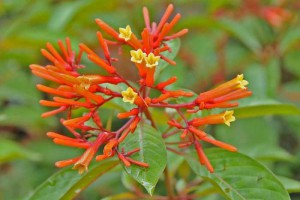
Bright orange-red blooms on a firebush. Photo courtesy UF/IFAS.
Salvia (Salvia spp.) – Salvias are great plants for bringing butterflies and hummingbirds to your garden and as a bonus, they have no serious pests. With hundreds of annual and perennial species coming in an array of colors and sizes, you can easily find one or more to complement your landscape. Salvias perform best in full sun environments and are considered drought tolerant.
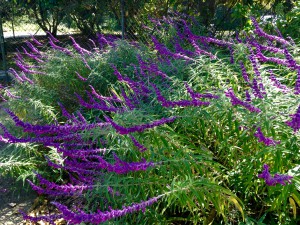
Deep purple blooms on a salvia in the landscape. Photo courtesy Taylor Vandiver.
Turk’s Cap (Malvaviscus arboreus) – Turk’s cap can add a cheerful pop of color at a time when little else is blooming. This old-fashioned Florida-Friendly shrub like perennial is related to the hibiscus. It’s known for its bright red flowers that always seem ready to open, but never do. Turk’s cap starts blooming in summer and keeps going until through winter, unless hit by a hard frost. It can grow in full sun and reach up to ten feet tall and ten feet wide, so give it room to grow. This easy-care native perennial requires little maintenance once it’s established.
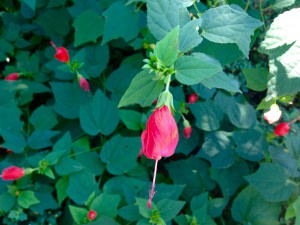
Turk’s cap showing off its unique blooms. Photo courtesy Taylor Vandiver
Coleus (Solenostemon scutellarioides) – When imagining fall color we often don’t consider coleus. However, the vibrant foliage can add interest to any landscape throughout the fall. Coleus is prized for its colorful foliage, which comes in shades of green, yellow, pink, red, and maroon. Coleus varieties can range from one to several feet in height. They can be used in hanging baskets, containers on patios, or in landscape beds. Coleus prefers partial shade and you can pinch the growing stems of young plants frequently to encourage dense foliage. Keep an eye out for mealybugs on coleus and use insecticidal soap if problems develop

Burnt orange foliage standing out amongst the neutral green of the landscape. Photo courtesy Taylor Vandiver.
Fore more information contact your local extension agent. Also you can visit us at gardeningsolutions.ifas.ufl.edu or edis.ifas.ufl.edu.









